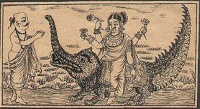Makara
Makara (devanāgarī: मकर) is a Sanskrit name for a mythical sea-creature in Hinduism, which in early art seems to have been inspired in a crocodile. It is generally depicted as half terrestrial animal (in the frontal part in animal forms of elephant or crocodile or stag, or deer) and in the tail part as aquatic animal, (as a fish tail or also as seal). He is the vahana (vehicle) of the Ganga (the goddess of river Ganges) and the sea god Varuna. The makara appears in many myths, and is endowed with magical powers, especially those related to the fertility of rivers and the sea.
In the Hindu zodiac it represents the astrological sign of Capricorn.
Theosophical view
T. Subba Row, interpreting the symbolical meaning of the word "Makara", wrote:
The letter Ma is equivalent to number five and Kara means hand. Now in Samskrt Tribhuja means a triangle, bhuja or kara (both are synonymous) being understood to mean a side. So, Makara or Pañchakara means a Pentagon.[1]
H. P. Blavatsky adds to the statement above: "the five-pointed star or pentagon representing the five limbs of man" and in a footnote says: "What is the meaning and the reason of this figure? Because, Manas is the fifth principle, and because the pentagon is the symbol of Man—not only of the five-limbed, but rather of the thinking, conscious MAN".[2] Because of this, she connects the term to the Kumāras, who endowed human beings with mind:
But very few are those who know—even in India, unless they are initiated—the real mystic connection which seems to exist, as we are told, between the names Makara and Kumâra. The first means some amphibious animal called flippantly "crocodile", as some Orientalists think, and the second is the title of the great patrons of Yogins (See "Saiva Purânas") the Sons of, and even one with, Rudra (Siva); a Kumâra himself. It is through their connection with Man that the Kumâras are likewise connected with the Zodiac.[3]
On a more macrocosmic interpretation, Subba Row wrote:
Makara is the tenth sign and the term "Dasadisa" generally used by Samskrt writers to denote the faces or sides of the universe. The sign in question is intended to represent the faces of the universe and indicates that the figure of the universe is bounded by Pentagons. If we take the pentagons as regular pentagons (on the presumption or supposition that the universe is symmetrically constructed) the figure of the material universe will, of course, be a Dodecahedron, the geometrical model imitated by the Demiurgus in constructing the material universe.[4]
See also
Online resources
Articles
- The Gift of the Makaras at Teosofia.com
Notes
- ↑ Tallapragada Subba Row, Esoteric Writings, (Adyar, Madras: The Theosophical Publishing House, 1980), 14.
- ↑ Helena Petrovna Blavatsky, The Secret Doctrine vol. II, (Wheaton, IL: Theosophical Publishing House, 1993), 576.
- ↑ Helena Petrovna Blavatsky, The Secret Doctrine vol. II, (Wheaton, IL: Theosophical Publishing House, 1993), 576.
- ↑ Tallapragada Subba Row, Esoteric Writings, (Adyar, Madras: The Theosophical Publishing House, 1980), 15.


